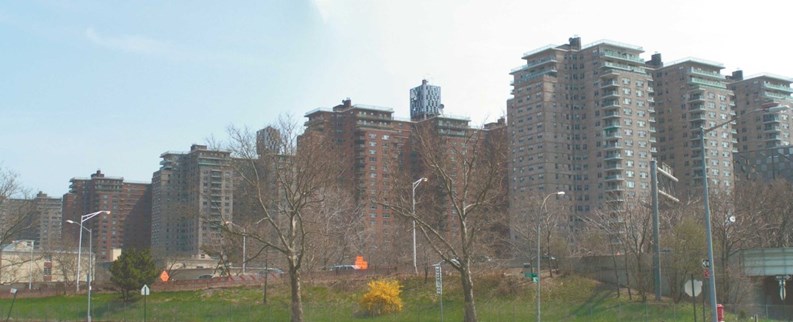If you lived in New York in the summer of 2003, chances are you know exactly what you were doing on Thursday, August 14th, at 4:15 in the afternoon. That’s when the ripple effects of the failure of an Ohio power plant caused most of the Northeastern United States and Canada to plunge into darkness. Well, it plunged into darkness where this reporter was—the windowless men's room of a Rockefeller Plaza office building. Fortunately, the sun was still shining, and I was already washing my hands.
Residents of North Shore Towers, however, a residential complex of three 34-story towers on the eastern extremity of Queens, were unaware that anything was wrong. North Shore Towers manufactures its own power at its own co-generation plant—how’s that for an amenity?—so outages that disrupt the rest of New York have no effect there. While darkness fell on the rest of the city that August evening, North Shore Towers, already tall and built atop the highest natural point in Queens, shone like a triple beacon.
“During the blackout, people knew to come here,” says Errol Brett, an attorney and the longtime general counsel for North Shore Towers. “It was hot, and they came for the air conditioning.”
Cities-Within-Cities
The night of the blackout made clear what had long been obvious: North Shore Towers is not your average co-op. It is, in effect, its own municipality, with its own zip code, its own movie theater, its own shopping center, its own library—and a $45 million-a-year budget. And while managing such a property requires dealing with issues that all property managers contend with—noise complaints, internecine squabbling, late maintenance fees, and so forth—the job, like the property, is much bigger.
“In effect, we’re a small city. We have issues with vendors, with city, state, and federal governments, with running the power plant,” Brett explains. “It’s not just waiting for a call that Mr. Smith is making noise, and Mr. Jones is getting angry. But we get those as well.”
As with any small city, the scale of the operation places even more importance on the governors—in this case, the board. North Shore Towers has nine directors on the board, each of them the chair of a subcommittee that focuses on a specific area. The subcommittees each have 10-15 members. So a number of the some 3,500 residents are directly involved with managing the property.
The committee structure is peculiar to extra-large properties like this one. Indeed, “I’ve never seen it in any other building,” Brett says.
The election process is also unlike what is found at smaller co-ops. The board members serve staggered terms to ensure consistency and preparations for the yearly elections, held the third week in June, begin in April. Candidates apply, and their resumes and photos are posted on the internal website. There is a candidate orientation (which tends to scare off anyone not serious about the job), followed by a candidate night at the movie theatre, where the candidates make speeches and field questions from residents in the audience. This is simulcast on the closed-circuit North Shore Towers TV station, and re-run often until election day. The election itself is run by an outside firm, American Arbitration, to ensure fair results.
The formal procedure “eliminates a lot of turmoil,” Brett says. In many other buildings, the election is held at the annual meeting, which “isn’t about who’s running for office, it’s people complaining—this eliminates that.”
North Shore Towers is managed by Glen Kotowski, a former deputy inspector with the NYPD, who Brett calls “the greatest manager in the city of New York.” He also speaks highly of the board members, and the shareholders in general, whom he describes as “extremely sophisticated.” Good relationships with the other members of the team is critical in running a ship as big as North Shore Towers. And that centers around three components: “Communication, information, and education is our goal,” says Brett.
The fact that the complex has its own movie theater, shops, professional offices, and arcade area make this easier. Although the place is large, it is in some ways more closely-knit than other co-ops. “We have a very vocal community,” says Brett. “Everybody knows everybody else.”
Indeed, the most important difference between managing a small building and managing an extra-large complex is “the management of the staff,” says Margie Russell, executive director of the New York Association of Realty Managers (NYARM). “The financials, that’s all the same. Following laws and codes, that’s all the same.” The challenge, she says, lies in building and maintaining good relationships. This sentiment is one you hear often when speaking with managers of massive properties.
Russell equates the government of an extra-large-sized property to a military organization: the integrity of the underlying structure is of the utmost importance. She cites The Tipping Point, in which author Malcolm Gladwell breaks down the numbers side of human relationships, determining that the number of relationships within a system expand exponentially when new people are added to the mix. In other words, having 50 direct reports is not particularly effective, because it’s too many relationships for one person to keep track of..
“It’s about attention to detail,” she says, “and small groups. Most people don’t realize how important that is in a large property.”
Anchoring Chelsea
Another example of a mega-co-op with its own management and sense of community is Penn South—or more officially, the Mutual Redevelopment Houses—in Chelsea on Manhattan's West Side.
This co-op sprawls from 23rd to 29th Streets between Eighth and Ninth Avenues, and is home to between 4,000 and 5,000 residents in some 2,820 apartments.
“It’s like a small city within a city,” says Brendan Keany, Penn South’s general manager. “We are unique by virtue of our size and are very community-oriented." Keany notes that Penn South has a uniformed security force, a staff of over 100 employees, its own power plant (which also enabled the development to have uninterrupted power during the blackout of 2003), a community garden, a gym, an extremely active seniors' program, a group of stores and restaurants on the premises, and even a theater.
The co-op interacts with its surrounding neighborhood as both a community anchor and an advocate, says Keany. "The Penn South board is involved with their local community board, as well as an organization called the Coordinating Council of Co-ops (CCC), in which we have sister members throughout New York City and the five boroughs.” The CCC allows cooperatives to work on co-op related legislative and legal issues, says Keany, and in addition to their CCC involvement, Penn South residents joined a number of other local organizations in a successful effort against the proposed West Side Stadium project a few years back. They are very active in their local police precinct, with a number of shareholders attending the 10th Precinct Community Council that meets monthly. "This allows shareholders to bring local community problems to the precinct on the spot," says Keany, "[as well as] giving them face time with the powers that be and the local police department.”
When a development the size of Penn South needs big repairs, it's a major undertaking, says Keany. Because the co-op is now nearly 50 years old, there have by necessity been some major capital improvement projects over the last decade or so. In the mid-1990s, for example, the buildings' windows were all replaced at a cost of about $11 million. In 2003, Penn South's underground electrical cables, which also had deteriorated, were replaced, a project that Keany said cost about $5 million.
Being self-managed allows Penn South to be flexible and operate almost like a distinct municipality, says Keany. “We generate our own electricity, completely devoid of Con Ed and have been since 1986,” he says. “We’re like a-city-within-a-city. We have 110 professional employees, an 800-spot parking lot on the property, approximately 20 retail ground floor spaces that we rent out, the Midtown Tennis Club, St. Vincent’s Clinic, and our own gym with over 500 members. The diversity of things you can get involved in are much greater when you are self-managed.”
Big in Brooklyn
On that dark August night in 2003, the lights were also on at Brooklyn's Amalgamated Warbasse Houses. “Houses” is a bit of a misnomer—these are five 24-story buildings on a 26.7 acre lot in Coney Island. With 2,585 units, the Amalgamated Warbasse Houses—a New York State Mitchell-Lama housing cooperative—constitute an even larger co-op than North Shore Towers. First occupied in 1964, they are also older than their Queens counterpart.
In complexes almost half-a-century old, things start to break down. This is the most exigent concern of the building’s longtime manager, Rochelle Captan. “There’s leaking pipes, there’s replacement of pipes—huge things a 46-year-old building has to face,” she says. “Fortunately, we have some wonderful people who work for us.”
Like Brett and Kotowski in Queens, Captan enjoys excellent working relationships with those she does business with every day. “Good relationships with the board of directors—that’s very important,” she says. “The people I’ve dealt with have been extremely bright and kind and nice. We can talk, we can analyze.” As for the president of the board, “I don’t know what I’d do without him.”
Like Russell, Captan understands that good relationships need to occur up and down the hierarchical pyramid, and not just laterally. “It’s very important to have a good staff,” she says. Her employees, she says, are “caring and wonderful. I think we have the best staff we’ve ever had.” She’s been at the helm of the Amalgamated Warbasse Houses for 32 years, so that’s no faint praise.
Extra-large properties tend to have many commercial vendors, adding yet another wrinkle of complexity to the face of the difficult job. Amalgamated Warbasse Houses features a bank, a grocery store, a deli, and an array of medical professionals, among other things. Does this pose problems? No, says Captan. “They are excellent people. There are no challenges at all.” The main issue is making sure not to let space to more than one of a given line. The property can’t accommodate two eye doctors, for example.
The ability to manage relationships bleeds into dealing with the residents, too. There are a staggering 8,000 of them at Amalgamated Warbasse Houses—one one-thousandth of the entire city. In effect, the property is a microcosm of the five boroughs of New York. Which means the residents really do run the gamut.
When asked for funny anecdotes about her decades as property manager, Captan says, “I could write a book.” But she stops there. She won’t name names or tell stories. “But I will say this: there’s a lot of very strange things happening all the time.”
Like New York City itself, super-sized co-ops and condos are mosaics made up of all kinds of people from all cultures and walks of life. Managing these types of properties is much like managing any other residential development, just on a much larger scale. At the end of the day, competent management and a strong sense of community are what keep the city's giant developments running smoothly—and that's true regardless of size.
Greg Olear is a freelance writer, novelist and a frequent contributor toThe Cooperator.







Leave a Comment